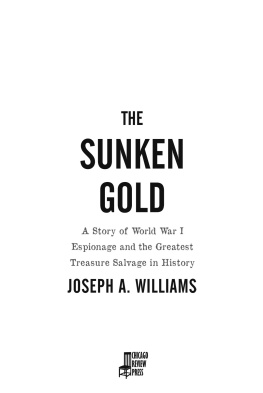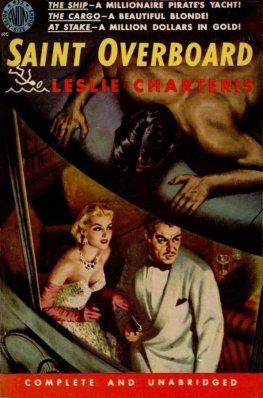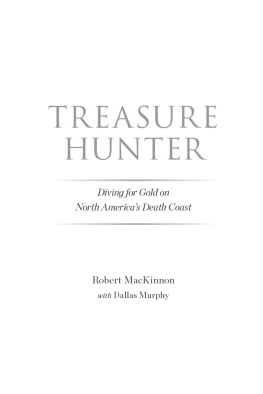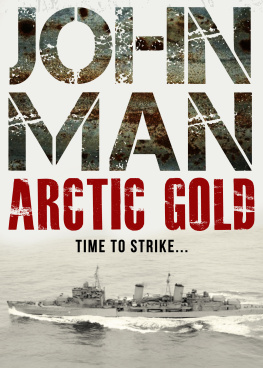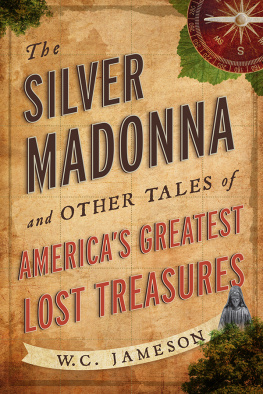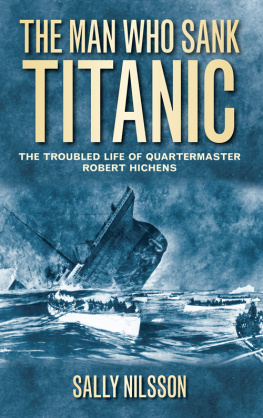Sommaire
Pagination de l'dition papier
Guide
Copyright 2017 by Joseph A. Williams
All rights reserved
Published by Chicago Review Press Incorporated
814 North Franklin Street
Chicago, Illinois 60610
ISBN 978-1-61373-761-3
Library of Congress Cataloging-in-Publication Data
Names: Williams, Joseph A., 1973- author.
Title: The sunken gold: a story of World War I espionage and the greatest treasure salvage in history/Joseph A. Williams.
Description: Chicago, Illinois: Chicago Review Press Incorporated, [2017] | Includes bibliographical references and index.
Identifiers: LCCN 2016057951 (print) | LCCN 2017004741 (ebook) | ISBN 9781613737583 (cloth: alkaline paper) | ISBN 9781613737590 (pdf) | ISBN 9781613737606 (kindle) | ISBN 9781613737613 (epub)
Subjects: LCSH: Laurentic (Steamship: 1909-1917) | World War,
1914-1918Naval operations, British. | ShipwrecksIrelandSwilly,
Lough, RegionHistory20th century. | Mines (Military
explosives)IrelandSwilly, Lough, RegionHistory20th century. | Damant, Guybon Chesney Castell, 1881-1963. | Treasure
troveIrelandSwilly, Lough, RegionHistory20th century. | SalvageIrelandSwilly, Lough, RegionHistory20th century. |
Espionage, BritishHistory20th century. | Submarines
(Ships)GermanyHistory20th century.
Classification: LCC D582.L38 W55 2017 (print) | LCC D582.L38 (ebook) | DDC 940.4/57dc23
LC record available at https://lccn.loc.gov/2016057951
Typesetting: Nord Compo
Map design: Chris Erichsen
The author has made every effort to secure permissions for the images in this book. If there is an oversight, please contact the publisher.
Printed in the United States of America
5 4 3 2 1
This digital document has been produced by Nord Compo.
For my daughter, Zo Margot
PREFACE
THE LAURENTIC MADE ITS FIRST impression on me while I was conducting research for my previous book, Seventeen Fathoms Deep. I found reference after reference to this salvage operation, especially to its central character, Captain G. C. C. Damant. I was amazed to find that there had been no books fully devoted to him or the topic, although there had been a chapter or two written about it. This naturally led me to assume that either it wasnt worthwhile writing about the Laurentic at length or it was a forgotten gem of a story.
It turned out to be the latter.
The bulk of my research came from thousands of pages of documents in the British National Archivesmainly official reports, records, and correspondence from the Admiralty records. This formed the underlying foundation of my narrative. However, since these records were official, by their nature they were largely devoid of human, personal touches. What I really wanted was to experience the Laurentic from the perspective of Captain Damant.
I explained my situation to Ruth Bloom, an able researcher with whom I had been working. She then tracked down Captain Damants relatives. A letter was then sent to the captains youngest and last surviving child, Mary Harrison. Mary, albeit getting on in years, was still very sharp, but she could not help me because of personal issues. My letter was put aside.
Leaving it at that, I continued my research and writing until some months later I received a letter in the mail from the United Kingdom. It was a cousin of Marys, Charles Darwent, who was visiting her and discovered my letter. Being a scholar, he knew firsthand about the problems of research and offered to help.
About a month later I found myself driving to the Country Corner Diner in Bethany, Connecticut. Charles, who was writing a biography of the artist Josef Albers, happened to be in the United States doing research at the Josef and Anni Albers Foundation in Bethany. I was passing through since I was doing some lectures in New England on Seventeen Fathoms Deep. I arrived and sent a text message. I slid into a booth and waited, nursing an ice water.
Charles arrived and introduced himself to me. He was surprised by my appearance. He commented, Mary asked me what I thought youd look like, and I said, I dont knowprobably an old guy with a beard.
As it turns out, Charles and I were about the same age, and perhaps because of my friendly, beardless face we easily slipped into talk concerning his family. I found it quite remarkable that cousins to what must have been the tenth degree still had close relationships. Charles explained to me, Lots of East Anglian interbreeding. Im surprised we dont all have two heads.
Over Reubens and French fries, Charles handed over photographs and a prcis that detailed the career of Captain Damant and was the basis for an unpublished memoir Damant had written but that had gone missing.
The prcis was enough for me to start, although it created even more tantalizing questions. After a few days, I wrote to Charles thanking him and urging him to track down the manuscript if it was practicable in any way. He graciously put the call out to all the Damant relatives across the world on my behalf.
Sure enough, Derek Damant, the sixth bishop of George in South Africa (now retired), wrote to Charles and attached a transcribed copy of the forgotten autobiography. The thousand thank-yous I extended to the family were not enough, for here was a document that provided dimensions of character to truly augment the story. What is more, hitherto unknown details concerning the covert work he and his divers performed on U-boats during the First World War further enriched this deep-sea-diving tale. After integrating this source into my working manuscript, I found that it increased the size of the initial manuscript by about 20 percent.
As my work progressed I found more resources still. A case in point is Mr. Ray Cossum, the current wreck owner of the Laurentic. I was only able to contact him via post, and we began a correspondence that culminated in a transatlantic phone call. The call, while awkward at times owing to our accent differences, nevertheless impressed upon me the ever-infectious enthusiasm that people have for the story of the Laurentic disaster and salvage, which by the time of the publication of this book will be one hundred years passed.
I was amazed by all the help I received on this project. I had a suspicion that I was going to be dismissed out of hand as an interloping Yankee. The opposite was true. Every person I met who knew the outline of the Laurentic and the life and work of Captain Damant affirmed that the story needed to be told in full. I took some solace in this and the fact that Arthur J. Marder wrote the definitive work on this period of British naval history as an American while living in Hawaii and California. While my book has neither the scope nor size of Marders multivolume From the Dreadnought to Scapa Flow, I hope that the reader finds Captain Damant and the Laurentics tale of courage, outstanding tenacity, and patriotism educational, entertaining, and ultimately inspirational.
PART I
The Titanic in Miniature
THE CITY OF LIVERPOOL was the strategic entry and exit port of Great Britains western approaches during the First World War. Foodstuffs, munitions, equipment, and weapons all passed through Liverpool first. Likewise, ships debarked from the city to voyage all around the globe to Britains far-flung colonies and dependencies. HMS Laurentic was one of these vessels and on January 24, 1917, was being loaded for its dangerous voyage to Halifax, Canada.
The Laurentic was a former transatlantic liner, built in 1908 by the famous White Star Line. The White Star Line was known for the outstanding design of its vessels and gave the world some of the most memorable ships of the age, especially its gigantic

